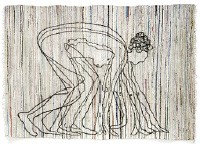The largest work of art in “Small Considerations,” Jean Flint’s installation at the Jones Hall Gallery at the U of M, is a tattered rag rug titled Scampering Woman. Stitched into its fabric is the figure of a woman with multiple arms and legs, naked except for the curlers in her hair and bending over like a runner at the start of a race. This woman is on a mission. Throughout the rest of the show, with Flint as her alter ego, she slows down and takes a good look at her revved-up body and mind that, each morning, start the day running.
Using twisted scraps of cloth, Flint simulates the body inside and out. In Mental Notes, for example, pieces of bound fabric are fastened with clothes pins to lines of string. They dangle inside an outline of a woman’s head. Dozens more spill out and pile up like scattered thoughts or viscera on the floor in front of her. Coils of fabric become convolutions of a human brain shaped into a skull in Disconnected. This work’s irregular edges, its loose strings, and its title suggest a brain and mind that, like the rag rug, are a little worn out.
To explore body, mind, and feelings, Flint knots and twists strips of fabric and lays them out on ungessoed, unstretched canvas for Scampering Woman II, a wall hanging. Both cloth and canvas are stained with umbers and burnt siennas. Silkscreened to the right of this raw, darkly beautiful metaphor for psychological and/or physical funk are two smaller versions of the multiple-limbed sprinter on the rag rug. These are some of the last images you see as you exit the exhibit. Mission accomplished — Flint seems to say — the woman is up and running again.
“Small Considerations” at Jones Hall Gallery through July 1st
While Jean Flint serves as shaman taking us on a journey into body and mind, photographer Ian Lemmonds proves himself a magus of light in the exhibition “Things I Found at Thrift Stores” at the L Ross Gallery.
Many of the prints blend the surreal, the mystical, the spiritual, and the everyday. One print features a large plastic goldfish lying on a hardwood floor. The cord that tethers this creature to the earth creates a small heart-shaped wound in the middle of glowing white light that blurs the bottom of the fish’s body. Two tiny plastic figures stand in front of the otherworldly icon. One of the figures, a father, looks down at his son who points excitedly toward the glowing fish.

Toys found at thrift stores combined with Lemmonds’ evocative use of light suggest that there is magic all around and inside us if only we would notice. A long-exposure photograph transforms a plump baby elephant with a 20-watt bulb inside its body into a round, radiant sun god floating above a small figure of a man walking in the shadows. Dressed in a 1950s-style suit and hat, the man calmly goes about his business, unaware of the transformation occuring just above his head. Another work brings to life a rabbit that has been reduced to a plastic repository of coins with the word “bank” emblazoned across its forehead. Lemmonds photographs the bunny from the cheeks up and shines a bright light behind its huge brown eyes that appear to look at us with wonder.
A bull in front of a mantle and blazing fireplace is one of the most unsettling images in the show. Like Lemmonds, this is a creature mesmerized by the light. But unlike the artist, who is able to envision countless scenarios, the bull, transfixed but uncomprehending, becomes a disconcerting image of courage and confusion, strength and helplessness.
Lemmonds turns toy horses and natural light into tableaux of possibility and joy. In one image, we glimpse a white pony galloping on a window sill between brightly lit windows. If we had looked an instant later, we sense that we would have missed the pony, that it would have vanished into pure white light.
“Things I Found at Thrift Stores” at L Ross Gallery through July 4th